Every gamer who has ever searched their shelves for just the right game to play likely knows the feeling: sometimes you just want a game that is both familiar yet has its challenges. One where everyone knows how to play, where some thought is required but is not a huge mental exercise, and the social interactions are as much fun as the winning or losing.
Catan hits all of these notes for me.
Even though some gamers have moved on from Catan, there’s still something nice about a game that got it all right the first time. The mix of mechanics and expandability keeps it engaging, making each game different and interesting. New layouts can lead to new ideas that give you the chance to try out new strategies.
If you’ve never had the chance to play Catan (formerly The Settlers of Catan), you should definitely give it a try. With over 27 million copies sold all over the world, finding someone with a copy shouldn’t be much of a problem. After all, that’s a global average of about one game of Catan per 289 people.
How To Play Catan
Setting Up the Game
Catan is centered around a modular board made up of 19 hexagonal tiles. Each hex features one of the five terrain types and produces the corresponding resource: light green pastures for Sheep; yellow fields for Wheat; red hills for Brick; dark green forests for Wood; gray, rocky hills for Stone.
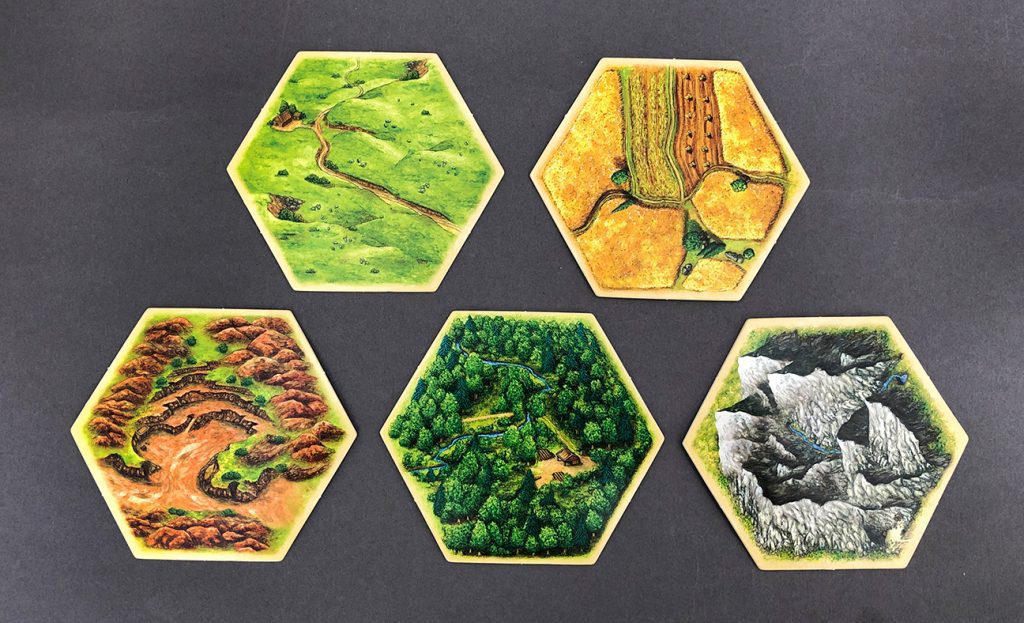
There’s also a single desert tile that importantly produces nothing. The Robber begins on this tile.
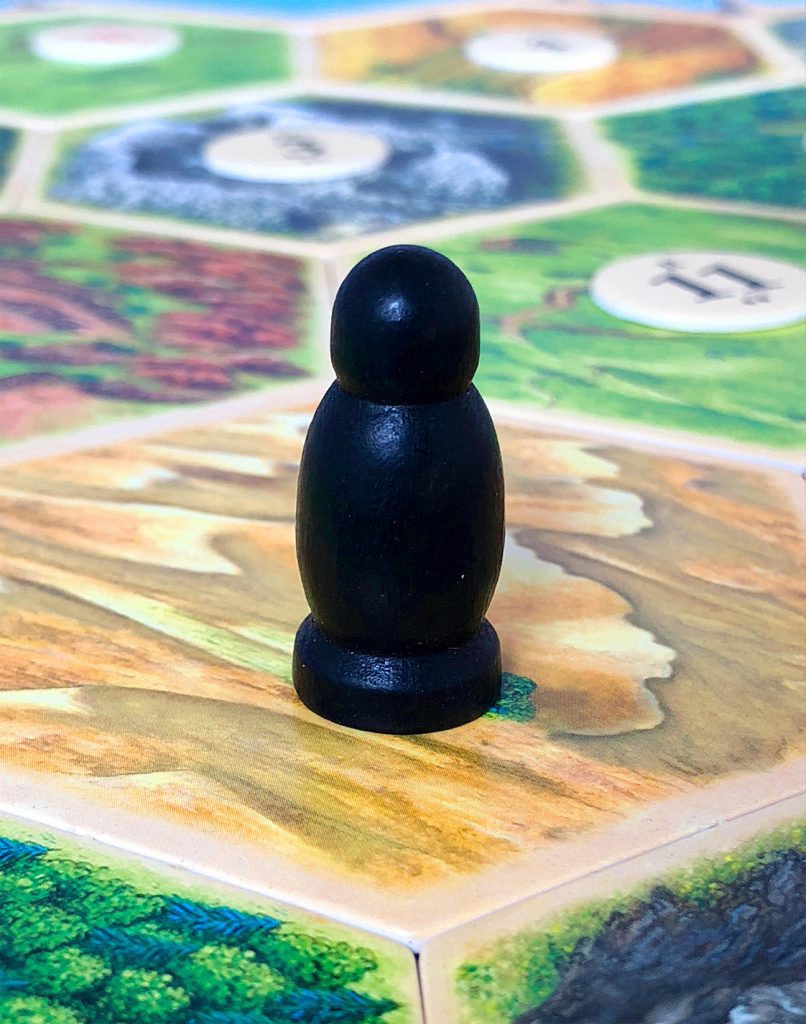
After the hexes have been laid out, round markers with numbers (2-6, 8-12) are placed on each tile. These chits indicate the number that will produce the terrain tile’s resource when rolled.
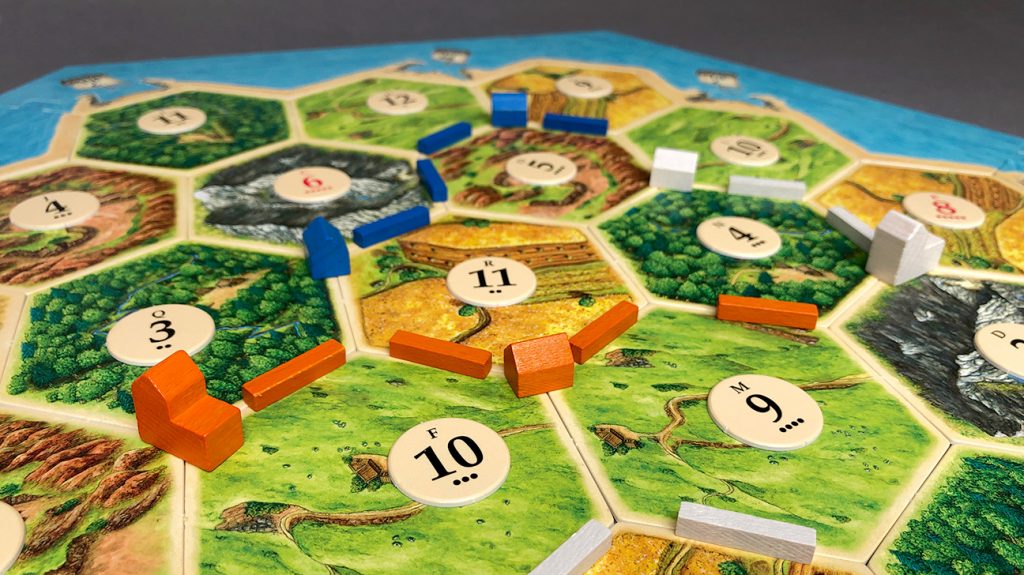
The five sets of Resource Cards are placed on the table.

As is the deck of Development Cards (see below).
Each player picks a color and takes the corresponding pieces and player aid, which explains the Resource Exchange Rate for the game.
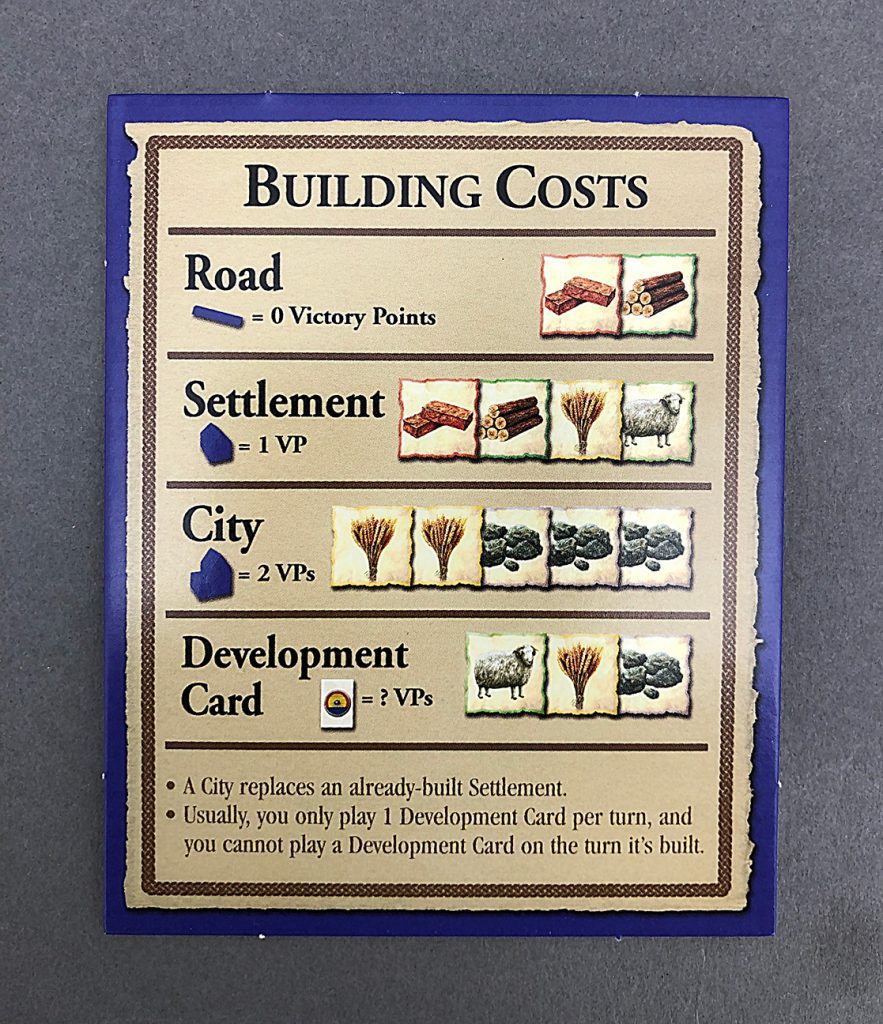
Before the game begins players take turns placing their initial Settlements until each player has placed two. A Settlement is placed on a corner between two or three hexes, and must be at least one empty corner away from any existing Settlements in each direction. Each initial settlement will start with one road. Roads are placed between hexes, along their edges. Once this is done, the game is ready to begin.
Playing a Turn
On a turn, each player takes the two six-sided dice and rolls them. All hex tiles with a number equal to the sum of the dice is activated. Any player with a Settlement adjacent to an activated tile gains one matching Resource Card for each Settlement on a matching tile.
After rolling the dice, the active player may then either pay the necessary cards from their hand to build a Road or Settlement, replace a Settlement with a City (which increases their yield to two resources), or buy a Development Card.
If they lack the required Resource Cards they can trade with other players or the bank. Other players decide for themselves if the trade is advantageous enough for them to accept, or whether to decline the trade. When trading with the bank, four of a kind can be traded for any one resource card. Alternatively, if a player has a settlement adjacent to one of the Ports, they can trade at a much more favorable rate. However, the player will still need to have the cards the Port requires.
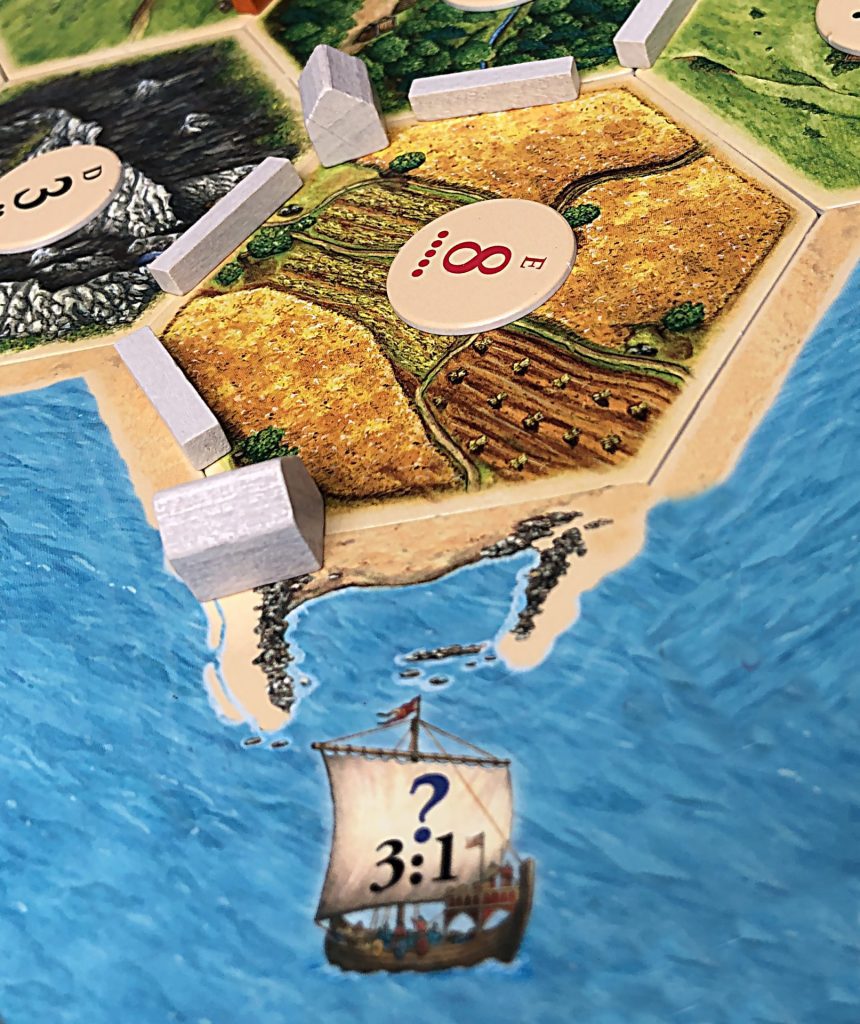
A standard Port lowers the general trading rate from 4:1 down to 3:1 for any resource. Specialty Ports reduce the rate down to 2:1 but only when trading in the resource listed.
At the end of a turn, the dice are passed to the player on their left, who then starts their turn by rolling the dice.
Players continue acquiring resources and trading them in for improvements that provide points. The first player to get to 10 points wins the game.
Three Points to Consider
Point One: The Robber
Remember that Robber who was placed on the desert tile at the start of the game? Remember how the hex tiles that make up the board have numbers on them except for the number 7? Yeah, the two are related.
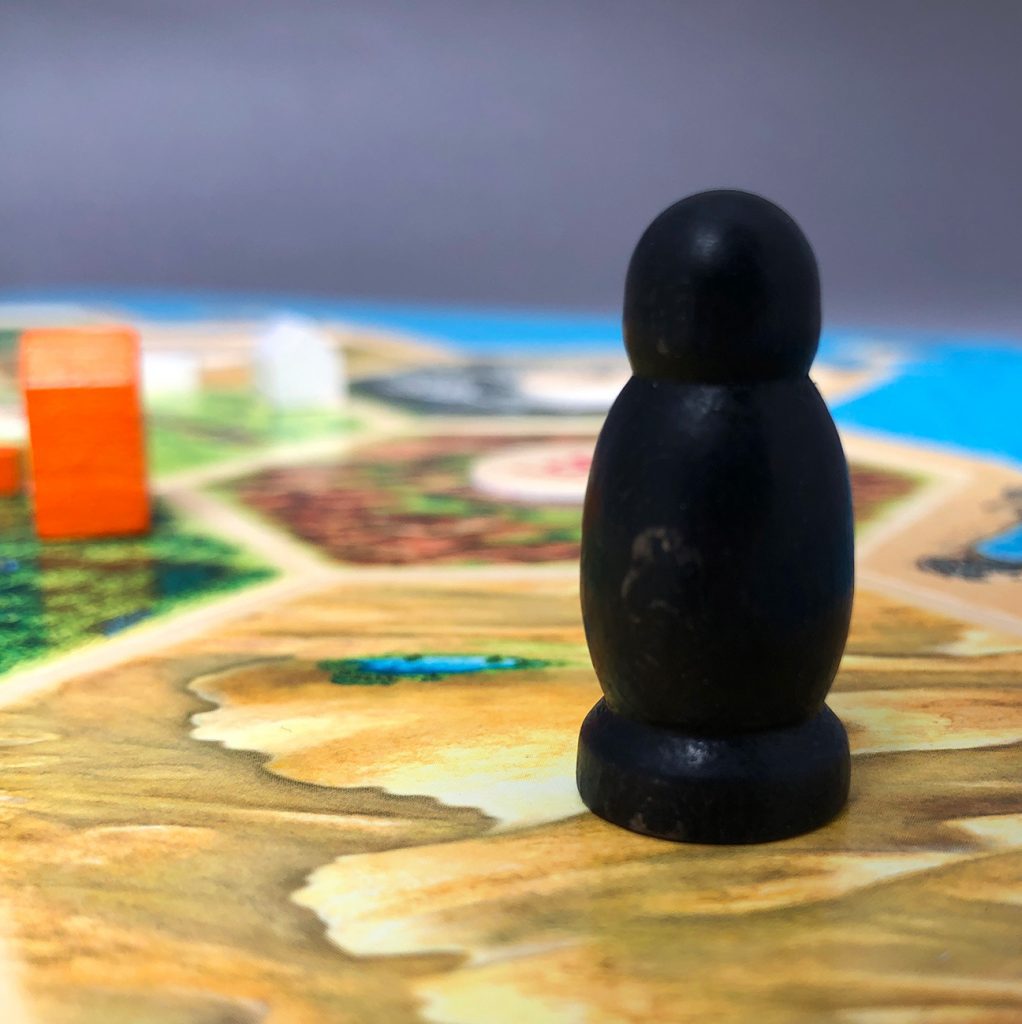
Statistically speaking, the number seven is the most likely sum of two six-sided dice. When a player rolls a seven, they move the Robber from the tile it is currently on to the tile of their choosing. This can be used to great advantage when another player is collecting way too many of that resource and needs to be stopped for a while.
The Robber prevents players from gaining resources from the tile it’s on. For instance, if a player has a Settlement on a wheat hex where the Robber is and that tile’s number is rolled, the player doesn’t get wheat from that tile.
Two additional things happen when a seven is rolled. All players must count the number of Resource Cards in their hand. Anyone with more than seven cards must immediately discard half of them.
Secondly, after moving the Robber, the active player looks to see which opponents have a Settlement or a City adjacent to the tile the Robber has been moved to. They then select one of those players and may steal a Resource Card from their hand at random.
Point Two: Development Cards
As mentioned earlier, one of the actions a player can take on their turn is buying a Development Card. Over half of these cards are Soldiers. (NOTE: In later editions, Soldiers were replaced by Knights. Since my edition uses Soldiers, that’s how I’ll refer to them.)
Soldiers, when played at the start of your turn, allow you to move the Robber. This is particularly useful when the Robber is on a tile you’re hoping to claim resources from. You follow the same steps as if the Robber had been activated by rolling a seven, except there is no discard for players who have more than seven cards.
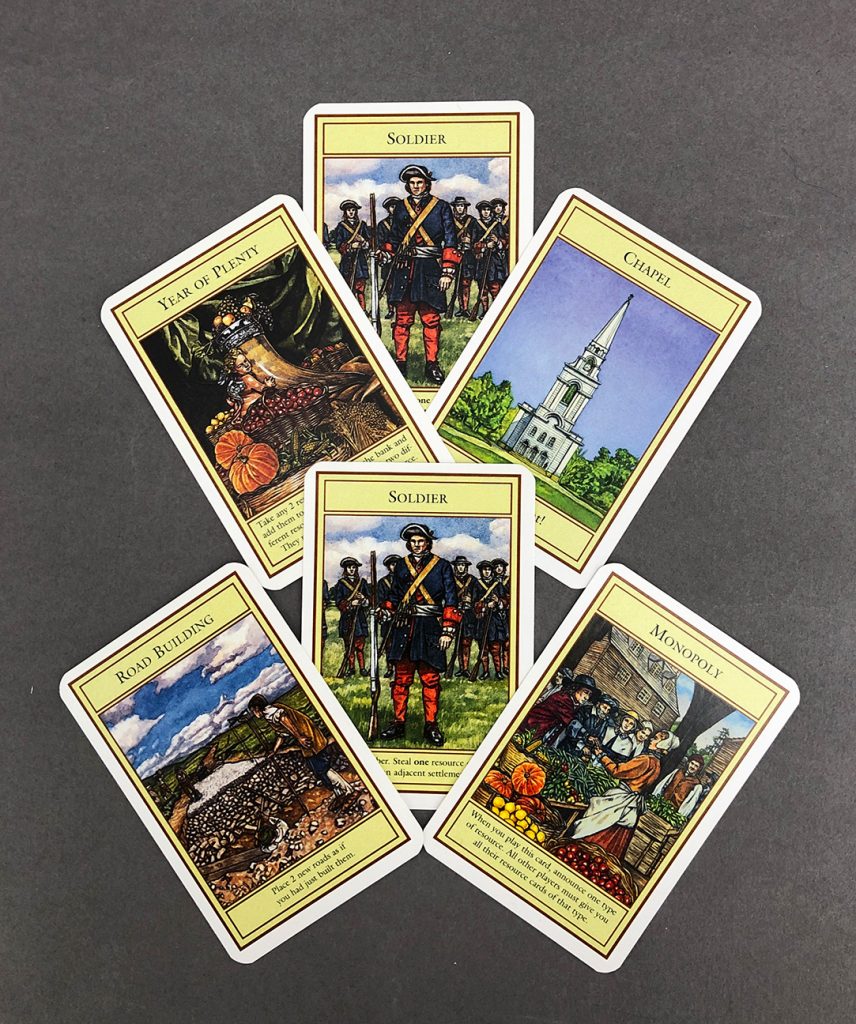
Other Development Cards can be equally, if not even more, helpful. The Year of Plenty Card allows you to take two resources of your choice from the bank. The Monopoly Card allows you to steal all the cards of a single resource from each of your opponents. Road Building allows you to build two new roads for free.
The remainder are City Building Cards. They are worth one victory point each.
Development Cards are kept face down in front of you until you choose to play them.
Point Three: Special Cards
There are two additional Special Cards in Catan that can be earned when players meet specific conditions. One is for having the Largest Army. The first player to play three Soldier Development Cards claims this bonus, which is worth two points.
The Largest Army card has a counterpart that rewards connected pathways. The first player who builds a contiguous road of five road pieces claims the Longest Road Card. This is also worth two points.

The player who first claims either card keeps it until another player builds an army or road that is larger/longer than theirs. That player then keeps the card until someone builds a bigger army or longer road, etc.
Why Catan is Still a Game Worth Playing
A classic remains a classic for good reasons. For me, Catan deserves the title due to its particular mix of gaming mechanics and its adaptability.
Catan is a Resource Management Game
Catan is all about managing your resources. Without the necessary resources, you cannot build, expand, or buy Development Cards. Every turn is about acquiring those five materials so you can convert them into things that earn you victory points. Some come into play early in the game, others can come later. In most cases, all five are necessary for a win.
Without those resources, you might as well just skip your turn and hand the dice to the player to your left. This means you need to constantly assess your strengths and weaknesses on the board and play accordingly.
Catan is a Negotiation Game
Regardless of how well you manage to place your two initial Settlements, it is very hard to win by relying solely on your own resources. Trading with other players is essential in playing Catan; for all players. And to be fair that’s part of the fun. If the player to your right is asking for ore, you know they’re hurting for some of those ore cards sitting in your hand. Is it worth giving up a resource, knowing that you are helping your opponent to convert a set of resources into something that will earn them a point? How much do you really need that card they’re willing to trade away?
However, Catan is not a Trading game, it’s a Negotiation game. You can negotiate for better deals when you’re ahead. Does this mean a friendly game of Catan can become cutthroat? Sure. But what game can’t?
Catan is a Game of Open Information
There is very little hidden information in Catan. Aside from the Development Cards, everyone knows who is getting what resource on any given turn. Pay attention to the game and you’ll have a good idea of what each player is holding in their hand. And what they aren’t.
Also, why is that player trying to trade for brick? You can look at your Resource Exchange Rate card and see that bricks are needed for Roads and Settlements. Which one is that player most likely trying to build — and, more importantly, where and how might that impact your plans? Are they trying to break your longest road? Are they looking to build at an intersection that would give them resources you’d rather they didn’t have?
Knowing why someone wants to trade with you is just as important as knowing why you want to trade with them. Given all of the Settlements, Cities, and Roads on the board, as well as the Development Cards stacking up in front of your opponents, you should have a good idea of how many points each player has and when trading needs to end.
Catan is a Luck-Based Game
The Abstract Purist in me recoils at the mention of six-sided dice. In general, the only time they’re acceptable is when they’re part of a larger set of polyhedral dice used when I play Dungeons & Dragons. (And, yes, that is a matter of Boardgame Cognitive Dissonance best left for another article.)
It doesn’t matter how well you plan, how deep your strategy is, how extensive your Settlements and Cities are, or how favorable your trade ratios might be, Catan still comes down to the random roll of the dice. Every turn, every decision comes down to whom the dice choose to favor on a given roll. And while that can be very frustrating for some, it can also be exciting. Maybe you built a Settlement next to a wheatfield with a 12 chit on it, and somehow it’s become your most valuable spot. Now you’re rolling in wheat, and it’s hilarious.
Think you’re winning? Just let a few rolls of the dice go in someone else’s favor and see how you feel. Think you’re losing? The dice could just as easily start rolling your way and gift you with resources galore — the very resources you need to claim enough victory points and win! It’s that randomness that keeps Catan fresh and fun for all, because even if all the good spots were taken when it was time to place your initial Settlements, you never know where your luck will take you.
Catan’s Expansions and Reskins Work Well
Catan has four expansions and five additional variants and scenarios to augment the base game. Some increase both the playing area and the types of resources, while others add thieving barbarians, sea-bound exploration, or special missions to the game.
Starfarers of Catan moves the game to outer space where you encounter new resources and space pirates. Game of Thrones Catan has you playing as a member of the Brothers of the Night’s Watch, defending Westeros against Wildlings who threaten both your plans and lands.
In late 2019 Catan announced the upcoming release of Catan – World Explorers, a game that takes Catan off of the gaming table and out into the real world. In a scenario that mashes up Catan with Pokémon Go, players will seek out the virtual Catan resources in their own communities to harvest, trade, and build their way to victory.
Catan is a Great Gateway Game
When looking for a game that will introduce people to the wider world of board games, it’s important to choose the right one. You want a game that clearly distinguishes itself from the list of emergency gift games on generic store shelves — the ones that most people played in their childhood. At the same time, you also want one that is easy to learn and has some familiar aspects to ease the transition.
Catan can be explained in just a few minutes. Setup and turn overview take a few minutes more. Dice and cards are common items, and wooden roads and houses aren’t too strange. Bartering and trading quickly show themselves to be enjoyable exchanges. Within the first few turns everything starts falling into place and new players get the hang of the game.
Even more experienced players who haven’t played Catan can appreciate the way the game brings together the different mechanics in a relatively simple and straightforward way. Despite the familiarity with other games that have come after it, the multiple ways of winning, the give-and-take between resources and trading with other players keeps Catan challenging.
Catan is Still Fun
The truth is Catan isn’t always the first game I pull out when turning new people on to the hobby. Sometimes it’s not even the second or third game I pull out, but it eventually makes its way to the table. After more than a decade of playing, it’s a game that my weekly gaming group decides to play when we’re interested in a break from our usual heavier games.
When I play Catan I feel like I’m revisiting an old and respected friend who not only challenges me, but one that I am certain I should be better at playing than I am. That means part of the challenge is not only me against the game, but me against the way I approach the game and my opponents. And that’s a big part of why I like Catan so much; despite the comforting familiarity, each game remains challenging in its own way for everyone around the table.


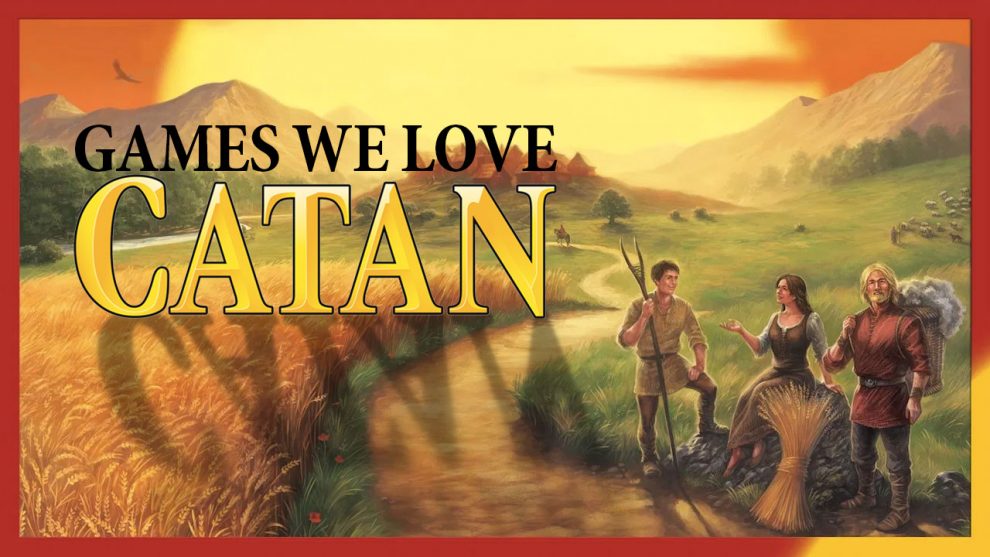
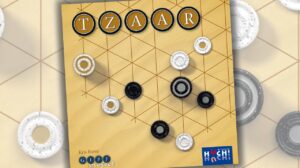
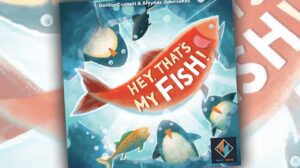
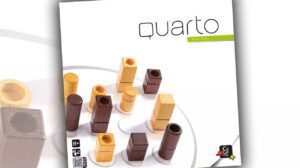





I love Catan. I live it for all of the reasons you list here.
My friend, Steve… he hates this game. Far too many games he has played where he gets no resources, nobody will trade those few he has, and he goes turn after turn with nothing to do. He has had games where he has a good spot where it seems the robber never leaves.
Yea… his experience is not as positive as mine. He refuses to play Catan or any offshoot he thinks might even be tangentially related to Catan. So I get to play, just not when he is around.
Thanks for the response, David. I came to Catan relatively late in my gaming life. After years of playing little other than abstracts, I approached it with some hesitation given the randomness of the dice. After many plays, Catan is one of the few exceptions to dice-rolling games that I’m happy to play.
Good read! I agree with everything you said, but the luck element drives me crazy. I’m ok with luck in games, but there’s something about the luck in Catan that I can’t get over. I do wish more modern games utilized negotiation and trade like Catan does though, love that.